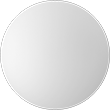High-Strength Fracture- and Wear-Resistant Zirconia Ceramic Rods and Discs

Ideal for applications that must resist bending and wear as well as carry heavy loads, these rods and discs are often used for sleeve bearings and shafts instead of metal. Added yttria gives this material more strength and lowers the chances of cracking from impact compared to standard zirconia, alumina, and silicon nitride ceramic. If cracks do occur, they will not spread, extending the life and reliability of this material. It also means this zirconia blend resists wearing down from rubbing against another part or abrasion from chemical slurries.
Zirconia ceramic resists bending better than alumina and silicon nitride ceramic but does not withstand rapid temperature changes or high temperatures as well as other high-performance ceramics.
For technical drawings and 3-D models, click on a part number.
- Color: White
- Maximum Temperature: 2700° F
- Fabrication: Sintered
- Porosity: 13%
- Compressive Strength: 350,000 psi
High-Strength Fracture- and Wear-Resistant Zirconia Ceramic Balls

- Color: White
- Temperature Range: See table
- Fabrication: Sintered
- Porosity: See table
- Compressive Strength: See table
Often used instead of metal in bearings and rollers, these balls are ideal for applications where strength under heavy loads and wear resistance is needed. It's the addition of yttria that gives this zirconia more strength and lowers the chances of cracking from impact than standard zirconia, alumina, and silicon nitride ceramic. If cracks do occur, they will not spread, extending the life and reliability of the material. It also means this zirconia blend resists wearing down from rubbing against another part or abrasion from chemical slurries.
These balls do not withstand rapid temperature changes or high temperatures as well as other high-performance ceramics such as alumina and silicon nitride ceramic.
For technical drawings and 3-D models, click on a part number.
| Diameter | Diameter Tolerance | Minimum Temperature | Maximum Temperature | Compressive Strength, psi | Porosity | Pkg. Qty. | Pkg. | |
| 1/8" | -0.00010" to 0.00010" | -112° F | 2700° F | 350,000 | 13% | 5 | 0000000 | 000000 |
| 3/16" | -0.00010" to 0.00010" | -112° F | 2700° F | 350,000 | 13% | 5 | 0000000 | 00000 |
| 7/32" | -0.00010" to 0.00010" | -112° F | 2700° F | 350,000 | 13% | 5 | 0000000 | 00000 |
| 1/4" | -0.00010" to 0.00010" | -112° F | 2700° F | 350,000 | 13% | 5 | 0000000 | 00000 |
| 3/8" | -0.00010" to 0.00010" | -112° F | 2700° F | 350,000 | 13% | 5 | 0000000 | 00000 |
| 1/2" | -0.05000" to 0.05000" | Not Rated | 1000° F | 300,000 | Not Rated | 1 | 0000000 | 0000 |
| 3/4" | -0.07500" to 0.07500" | Not Rated | 1000° F | 300,000 | Not Rated | 1 | 0000000 | 00000 |
| 1" | -0.10000" to 0.10000" | Not Rated | 1000° F | 300,000 | Not Rated | 1 | 0000000 | 00000 |
| 3mm | -0.00250mm to 0.00250mm | -112° F | 2700° F | 350,000 | 13% | 5 | 0000000 | 00000 |
| 4mm | -0.00250mm to 0.00250mm | -112° F | 2700° F | 350,000 | 13% | 5 | 0000000 | 00000 |
| 5mm | -0.00250mm to 0.00250mm | -112° F | 2700° F | 350,000 | 13% | 5 | 0000000 | 00000 |
| 7mm | -0.00250mm to 0.00250mm | -112° F | 2700° F | 350,000 | 13% | 5 | 0000000 | 00000 |
| 8mm | -0.00250mm to 0.00250mm | -112° F | 2700° F | 350,000 | 13% | 5 | 00000000 | 00000 |
| 10mm | -1.00000mm to 1.00000mm | Not Rated | 1000° F | 300,000 | Not Rated | 5 | 0000000 | 00000 |
| 11mm | -1.10000mm to 1.10000mm | Not Rated | 1000° F | 300,000 | Not Rated | 1 | 000000 | 00000 |
| 12mm | -1.20000mm to 1.20000mm | Not Rated | 1000° F | 300,000 | Not Rated | 1 | 0000000 | 00000 |
| 16mm | -1.60000mm to 1.60000mm | Not Rated | 1000° F | 300,000 | Not Rated | 1 | 0000000 | 00000 |
| 17mm | -1.70000mm to 1.70000mm | Not Rated | 1000° F | 300,000 | Not Rated | 1 | 0000000 | 00000 |
| 25mm | -2.50000mm to 2.50000mm | Not Rated | 1000° F | 300,000 | Not Rated | 1 | 0000000 | 00000 |
Fracture- and Wear-Resistant Zirconia Ceramic

- Color: Off-White
- Max. Temperature: 1000° F
- Fabrication: Fired
- Porosity: 13%
- Compressive Strength: 254,000 psi
As fracture resistant and durable as metal, this temperature-resistant zirconia ceramic has been fired to obtain a high hardness and can be used in high-wear applications.


























